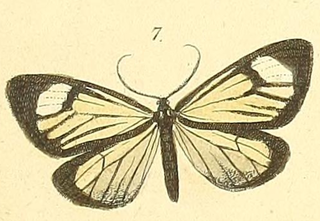
Oenosandridae is a family of Australian noctuoid moths. Genera include:

Notodontidae is a family of moths with approximately 3,800 known species. The family was described by James Francis Stephens in 1829. Moths of this family are found in all parts of the world, but they are most concentrated in tropical areas, especially in the New World.

Ephialtias bryce is a moth of the family Notodontidae. It is endemic to the basin of the Rio Tapajos in Brazil.
Sagittala is a genus of moths of the family Notodontidae. It consists of only one species, Sagittala peba, which is found in Panama and Costa Rica.

Cleptophasia is a monotypic moth genus of the family Notodontidae described by Prout in 1918. It consists of only one species, Cleptophasia scissa, first described by Warren in 1909, which is found in Brazil, French Guiana and Venezuela.

Heterocampa is a genus of prominent moths in the family Notodontidae. There are about 18 described species in Heterocampa, found in North, Central, and South America.

Disphragis is a genus of moths of the family Notodontidae erected by Jacob Hübner in 1820. The genus is confined to the New World and it contains about 137 species.

Schizura is a genus of prominent moths in the family Notodontidae. There are about eight described species in Schizura.

Cecrita guttivitta, the saddled prominent moth, is a species of moth of the family Notodontidae. It is found in North America, including Alabama, Arkansas, Connecticut, Delaware, Florida, Georgia, Illinois, Indiana, Iowa, Kansas, Kentucky, Maine, Maryland, Massachusetts, Minnesota, New Brunswick, New Hampshire, New Jersey, New York, North Carolina, Ohio, Oklahoma, Ontario, Pennsylvania, South Carolina, Tennessee, Vermont, Virginia, West Virginia and Wisconsin.
Erbessa labana is a moth of the family Notodontidae first described by Herbert Druce in 1895. It is found in Venezuela, Ecuador, Peru and Brazil.
Phaeochlaena gyon is a moth of the family Notodontidae first described by Johan Christian Fabricius in 1787. It is endemic to the Guyana Shield and points west, at least as far as the Upper Amazon basin of Colombia and Ecuador.
Brachyglene crocearia is a moth of the family Notodontidae first described by William Schaus in 1912. It is found in Costa Rica, Honduras and Guatemala.
Dioptis butes is a moth of the family Notodontidae first described by Herbert Druce in 1885. It is found from Costa Rica north to Belize and Veracruz in Mexico.

Monocreagra pheloides is a moth of the family Notodontidae first described by Cajetan and Rudolf Felder in 1874. It is found in Colombia, Ecuador and Peru.
Pareuchontha grandimacula is a moth of the family Notodontidae. It is restricted to southern Peru and Bolivia.

Dunama is a genus of moths of the family Notodontidae described by William Schaus in 1912.
Dicentria violascens is a moth of the family Notodontidae. It has been recorded from Mexico south to Brazil. However, violascens is a species complex of at least six cryptic species.
Nystaleinae is a subfamily of the moth family Notodontidae. The subfamily was described by William Trowbridge Merrifield Forbes in 1948.

Heterocampinae is a subfamily of prominent moths in the family Notodontidae. There are at least 60 described species of Heterocampinae in North America.










